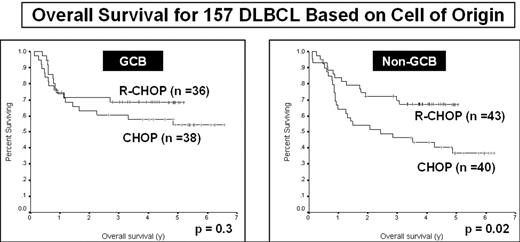Abstract
Background: The cell of origin (COO) distinction provides a prognostic and biologically relevant subclassification of DLBCL. Germinal center B cell (GCB) and non-GCB subtypes were originally characterized by gene expression studies and subsequently validated at the protein level by Hans et al., Blood 193: 275–82 (2004). The addition of R to CHOP chemotherapy has been shown to improve the outcome of patients with DLBCL. The underlying mechanism(s) responsible for this effect is largely unknown. However, it is known that R may preferentially prevent chemotherapy failure in DLBCLs that express Bcl-2 protein or fail to express Bcl-6 (
Method: We identified 163 patients with DLBCL treated with either CHOP or CHOP-R with available paraffin blocks and interpretable immuno-staining. All were de novo DLBCL cases diagnosed between 1999 and 2002 at the BCCA. The two treatment cohorts represent consecutive eras of therapy (
Results: Patients were treated with either CHOP (81) or CHOP-R (82). Their clinical characteristics, including the IPI, were evenly matched. The median follow-up of living patients was 4.4 y. The IPI was predictive of overall survival (OS) (p<0.0001) for the entire study population. Six cases had uninterpretable immunostains resulting in 74 cases with a GCB phenotype and 83 with a non-GCB phenotype (n = 157). Overall, 71% and 75% of the cases over-expressed Bcl-2 and Bcl-6, respectively. Bcl-2 protein was expressed in 70% GCB cases and 73% non-GCB (p= 0.72). Bcl-6 was expressed in 96% GCB cases and 63% non-GCB cases (p<0.0001). In univariate analysis, the addition of R was associated with a better prognosis in the non-GCB cases (p=0.02), but not in the GCB cases (p=0.3). This survival difference was not solely explained by either Bcl-2 or Bcl-6 expression. The addition of R to CHOP chemotherapy and IPI were independent predictors of OS in non-GCB DLBCL (p=0.02; p=0.016, respectively). The addition of R was also of prognostic importance in the lymphomas over-expressing Bcl-2 (p=0.0081).
Conclusion: Immuno-chemotherapy using CHOP-R is associated with better OS in DLBCL, due largely to its effect on the non-GCB subgroup. Although Bcl-2 expression does not contribute to the determination of COO distinctions, the OS of Bcl-2-positive DLBCL patients is significantly improved by the addition of R. These results provide insight into the possible mechanisms by which R exerts its beneficial therapeutic effect.
Overall Survival for 157 DLBCL Based on Cell of Origin
Disclosures: Basic and fellowship funding from Roche Canada.; Honoraria from Genentech, Roche, Genitope, Biogen Idec.; Ad Board member for Roche, Genentech, Lilly, Genitope and Biogen Idec.
Author notes
Corresponding author


This feature is available to Subscribers Only
Sign In or Create an Account Close Modal